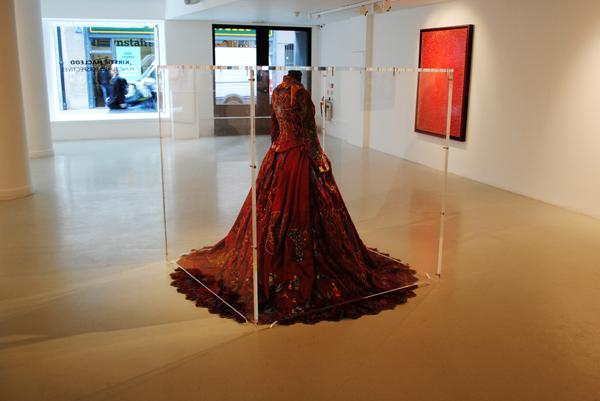Rook & Raven presents ‘Punctured Perspectives’, the first UK solo show of British artist Kirstie MacLeod. The artist is known for her unique and contemporary approach to the fine art of embroidery, juxtaposing the skill with the sensibilities of contemporary fine art, to create an altogether unique fusion. MacLeod exhibits a wide spectrum of works that pay homage to this intricate skill – the primary focus of the artist’s practice – which has become the subject of study in many distinguished needlepoint bodies including the Royal School of Needlework.
The artist juxtaposes this traditional skill with the sensibilities of contemporary art practice and thinking, re-contextualising embroidery through the addition of a layer of language that would be otherwise absent. MacLeod’s first solo show at the gallery includes ongoing projects, all with this particular thematic underpinning – with the centre-piece of the exhibition being the artist’s decade-long Unesco supported global embroidery project ‘Barocco’. The work is a fusion of performance piece, sculpture, and a Richard Long-esque art journey – in this case of object and not necessarily person.
Charting the journey of this garment as it is embroidered by countless individuals and tribes – Since 2009 – the dress has travelled around the world being continuously embroidered and added to by 50 different participants to date. The work’s most recent contributors include the Bedouin Fanasina collective, a group of female embroiderers based in Egypt’s Sinai who provide economic independence and education to women in the region. Taken from the ancient Portuguese word for a “rough or imperfect pearl”. The artist began her exhibition at Rook & Raven with a performance piece where MacLeod sat within a central Perspex cube simultaneously wearing and embroidering the ornate red dress that filled the installation cube around her.
The eventual aim of the work is a transformative one; eventually the red dress will be so replete with embroidery as to undergo the transformation from collaborative action, intervention, and performance – to sculpture, and/or installation. The piece will conclude in 2019, having been embroidered to the extent that it will become a free-standing object. The work will then be placed within the Perspex cube that the artist used for her performance work; becoming a vitrine for a sculpture.
‘Barrocco’ is in some respects similar to Mail Art, the populist artistic movement centred on sending small scale works through the postal service. It initially developed out of the Fluxus movement in the 1950s and 60s – but on a larger scale – the journey of the work is part of its identity, process, and in fact function. A signifier of the temporal and physical nature of the process inherent in the creation of the piece. The surface of the dress layered with embroidery slowly transforming into a specific topographical map – completely particular to the work’s journey – and reflective of the burgeoning sculptural landscape of the object.
The artist also employs the physical functions of embroidery as a part of the language of her works. The act of puncturing forms is expressed as a violent act, the artist even using a drill to illustrate her point – with the resulting hole often alluding to the nature of the void, a point of spiritual focus, at once microcosmic and macro-cosmic. There is also the motif of the circle running through many of the artist’s works. This not only relates to the methodical process of MacLeod’s practice, with the act of creating the hole becoming a form of meditation through repetition; but these are also signifier’s of the religious and the paganistic – symbolism of the spiritual weight of the void, and maybe the ouroboros – perhaps a visual joke concerning the eternal return of embroidery?
But in fact the artist challenges the viewers perception of embroidery as ‘feminine’, or ‘peaceful’, instead presenting it as a methodological process, an alternative to cliché, with the artistic function of expressing cultural identity, with a temporal and historical arc of process. In fact where Joseph Beuys used fat, Marc Quinn used his own blood, or Richard Serra expressed the sheer weight of a work, all achieved a truth to materials, a tenet of modern architectural and sculptural thinking and practice. In this instance MacLeod’s work is a truth to process, in which the artisan’s underlying method becomes the principal tool for the artist’s topographical and temporal system of inquiry.
Kirstie MacLeod: Punctured Perspectives – Rook & Raven – until 4 April 2015
Words: Paul Black, photo P A Black and Vine video : P A Black © 2015 all rights reserved

